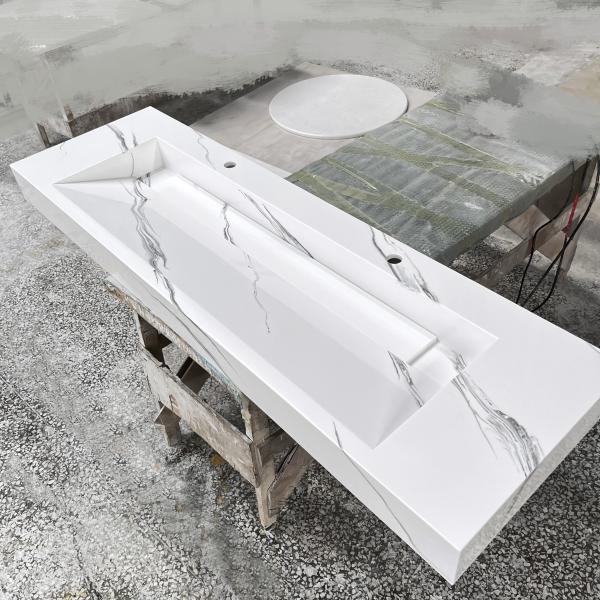
Synthetic marble countertops are a popular choice for modern homes and commercial spaces due to their luxurious appearance and superior performance. Made from a blend of man-made synthetic stone and resin, this material mimics the beauty of natural marble but is more durable and affordable. However, in order to ensure the longevity and beauty of your faux marble countertops, proper cleaning and maintenance is crucial.

Understanding Artificial Marble
Artificial Marble is a synthetic material made from natural stone fragments combined with resin. It has a smooth surface, rich colors, and varied textures that mimic the look of natural marble, but is usually more affordable. Additionally, synthetic marble countertops offer better durability and lower maintenance needs, but that doesn't mean it's completely maintenance-free. Understanding its characteristics is the first step to effective cleaning and maintenance.
Daily Cleaning
1. Prepare appropriate cleaning agents
Mild cleaners: Choose mild liquid cleaners and avoid cleaners with acidic or alkaline ingredients, as these may cause damage to the countertop.
Avoid strong acids and alkalis: such as bleach, stain remover, etc., as these chemicals may affect the surface luster and color of Artificial Marble.
2. Cleaning tools
Soft cloth or sponge: choose soft fabric or sponge, avoid using wire brush or hard cleaning tools, these may scratch the countertop.
Water: Use to rinse the cleaning agent residue on the countertop.
3. Cleaning Steps
Cleaning agent solution: Mix a mild cleaning agent with warm water, stir well and then dip a soft cloth or sponge into the solution.
Wipe the surface: Gently wipe the countertop with a damp cloth, making sure to cover all areas, especially nooks and crannies where dirt may accumulate.
Rinse: Rinse the countertop with clean water, making sure the cleaner is completely rinsed away.
Dry: Dry the countertop with a clean, dry cloth to prevent water stains and marks from remaining.
Dealing with stains and spills
1. Timely processing
Alcohol and grease: For grease, alcohol, coffee and other stains, they should be cleaned up as soon as possible to prevent the stain from penetrating and solidifying.
Fruit juices and seasonings: If spattering occurs, especially acidic fruit juices and seasonings, immediately rinse with water and wipe dry.
2. Removing stubborn stains
Specialized cleaners: For stubborn stains, use a stain remover designed for artificial marble. Follow the instructions to avoid damage to the countertop.
Light grinding: For stubborn stains, you can use a very fine grinding paste. After gently wiping, rinse with water and dry with a dry cloth.
Protecting the countertop
1. Use cutting boards and mats
Cutting board: When cutting food on the countertop, be sure to use a cutting board to avoid cutting directly on the countertop, which can prevent scratches.
Heat-insulating pads: Use heat-insulating pads or mats when placing hot pans, skillets, and other items to protect the countertop from high-temperature damage.
2. Prevent heavy objects from hitting
Avoid dropping heavy objects: Avoid dropping heavy objects on the countertop, which may cause cracks or breakage.
Temperature control: Although artificial marble is resistant to temperature changes, long-term high-temperature exposure may result in color changes or surface damage.
Regular Maintenance
1. Application of protective agent
Regular application: The use of protective agents designed for artificial marble can help enhance the surface gloss and stain resistance. Apply regularly according to product instructions, usually every few months or once a year.
Shine Restoration: Some protectants can also restore the shine of the countertop and keep it looking like new.
2. Periodic Inspection
Check for Damage: Periodically inspect your countertop for scratches, cracks or other damage. If any are found, take timely measures to repair them.
Maintenance records: Record the maintenance and restoration to keep track of the condition and maintenance history of the countertop.
Responding to small cracks and scratches
1. Small crack repair
Repair agent: for small cracks, you can use artificial marble repair agent to deal with. Repair agent usually includes filler and color matching agent.
Repair steps: clean the cracked area, follow the instructions of the patching agent, including filling the cracks, smoothing the surface and drying.
2. Specialized Repair
Treatment of large cracks: For larger or deeper cracks, it is recommended to contact a repair professional. Professionals have the necessary tools and experience to ensure repair results and long-term use of the countertop.
Avoid Common Mistakes
1. Do not use sanding or abrasive cleaners
Avoid scratching: Scrubbing or abrasive cleaners may scratch the countertop, causing the surface to lose its luster or develop scratches.
2. Don't use strong acids and bases
Chemical damage: strong acid and alkali will cause irreversible damage to the artificial marble surface and should be avoided.
3. Don't put wet things for a long time
Prevent water damage: placing wet objects on the countertop for a long time may lead to water damage and discoloration, clean up the water stains in time to keep the countertop dry.
Artificial Marble Tops are popular in the market due to their unique beauty and durability, but in order to keep them in the best condition and prolong their service life, they must be properly cleaned and maintained. By cleaning regularly, treating stains, protecting your countertops, performing regular maintenance, and repairing cracks and scratches in a timely manner, you can ensure that your faux marble countertops will always retain their original luster and beauty. Mastering these cleaning and maintenance tips will help you maximize the superior performance of your faux marble countertops and make them work well in your living or work space.